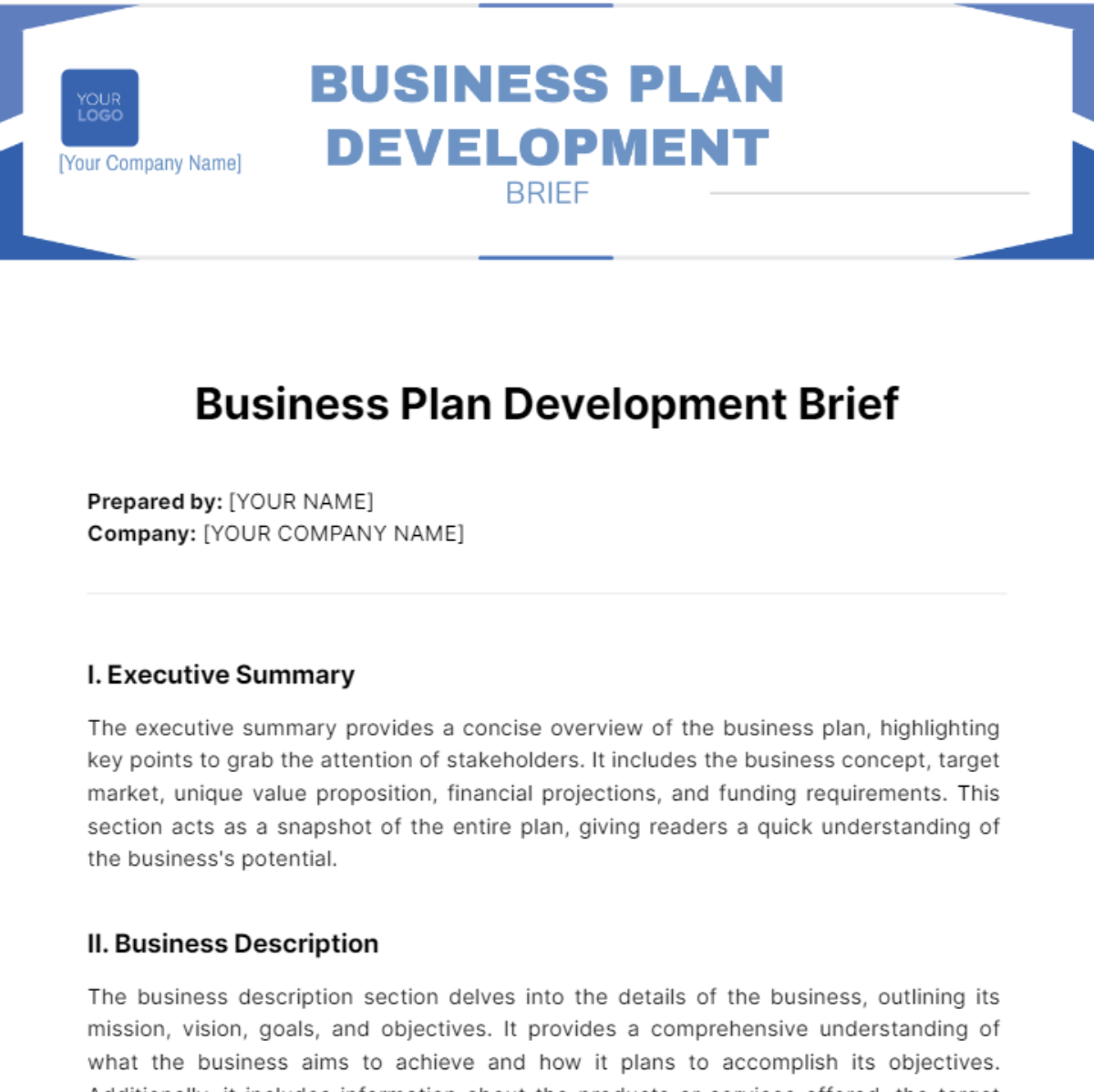Free Business Plan Development Brief

Prepared by: [YOUR NAME]
Company: [YOUR COMPANY NAME]
I. Executive Summary
The executive summary provides a concise overview of the business plan, highlighting key points to grab the attention of stakeholders. It includes the business concept, target market, unique value proposition, financial projections, and funding requirements. This section acts as a snapshot of the entire plan, giving readers a quick understanding of the business's potential.
II. Business Description
The business description section delves into the details of the business, outlining its mission, vision, goals, and objectives. It provides a comprehensive understanding of what the business aims to achieve and how it plans to accomplish its objectives. Additionally, it includes information about the products or services offered, the target market, and the unique selling proposition that sets the business apart from competitors.
III. Market Analysis
Market analysis is a crucial component that involves researching and analyzing the target market, industry trends, competitors, and potential opportunities and threats. This section provides an in-depth understanding of the market landscape, including customer demographics, buying behaviors, and market size. It also identifies key competitors and assesses their strengths, weaknesses, opportunities, and threats.
IV. Marketing and Sales Strategy
The marketing and sales strategy outlines the plans for promoting the business, acquiring customers, pricing strategies, distribution channels, and sales forecasts. It includes a detailed marketing plan that outlines tactics for reaching the target market effectively. Additionally, it highlights sales strategies and projections to achieve revenue targets.
V. Operations Plan
The operations plan details how the business will be managed on a day-to-day basis, including organizational structure, staffing requirements, production processes, and suppliers. It provides insights into the operational workflow and ensures efficient resource allocation. This section also addresses any legal and regulatory requirements associated with the business operations.
VI. Financial Plan
The financial plan includes projections for revenues, expenses, cash flow, and profitability. It outlines the startup costs, funding sources, and expected return on investment. Additionally, it includes financial forecasts for the first few years of operation, including income statements, balance sheets, and cash flow statements. This section helps stakeholders understand the financial feasibility and sustainability of the business.
VII. Appendices
The appendices include additional supporting documents such as resumes of key team members, market research data, legal documents, and any other relevant information. These documents provide supplemental information that enhances the understanding of the business plan and supports the key assumptions and strategies outlined in the main sections.
- 100% Customizable, free editor
- Access 1 Million+ Templates, photo’s & graphics
- Download or share as a template
- Click and replace photos, graphics, text, backgrounds
- Resize, crop, AI write & more
- Access advanced editor
Foster robust business strategies with Template.net's Business Plan Development Brief Template. This editable resource enables seamless customization, ensuring alignment with your vision and objectives. Crafted for efficiency, it's editable in our Ai Editor Tool, facilitating dynamic adjustments to meet evolving market demands. Drive growth and secure investments with comprehensive business plans tailored to your unique needs and aspirations.
You may also like
- One Page Business Plan
- Coffee Shop Business Plan
- Restaurant Business Plan
- Food Business Plan
- Real Estate Business Plan
- Executive Summary Business Plan
- Cover Page Business Plan
- Nonprofit Business Plan
- Daycare Business Plan
- Construction Business Plan
- Startup Business Plan
- Medical Business Plan
- Bakery Business Plan
- Service Plan
- Hotel Business Plan
- Catering Business Plan
- School Business Plan
- Healthcare Business Plan
- Transportation Plan
- Sports Plan
- Car Wash Business Plan
- Salon Business Plan
- Clothing Business Plan
- Farming Business Plan
- Boutique Plan





























